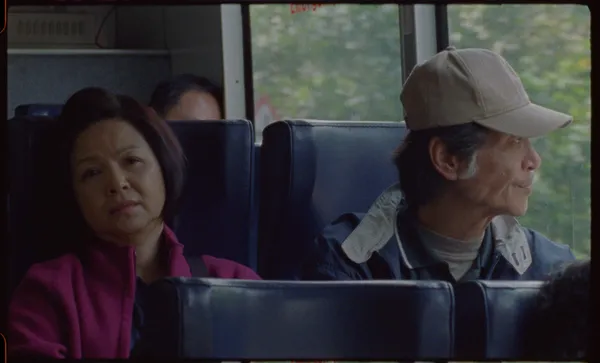 |
| A Journey In Spring Photo: Queer East |
Best Director award winners at Tribeca 2023 for their film A Journey In Spring, Peng Tzu-hui and Wang Ping-wen are continuing to present it on the festival circuit, with its latest screening being at the Queer East film festival, which showcases LGBTQ+ related work from Asia. Although this may seem to be a secondary theme in their film – the central characters’ son is in a same sex relationship – that detail has a significant effect on the central relationship and how the characters fit into society.
Khim-hok (King Jieh-wen) and Siù-tuān (Yang Kuei-mei) appear at first glance to be a couple who hate each other, but when Siù-tuān dies, Khim-hok is so distraught that he keeps her body in the freezer as he mentally works back through key moments in their shared past in search of understanding. It’s a thoughtful portrait of late life experiences, so I’m surprised by young the directors turn out to be when we meet. It’s also an exquisite piece of slow cinema, which I know is fashionable at the moment in their native Taiwan, but all the same, I wonder if there were additional reasons for it in this case.
There are, says Peng, with the aid of a translator. She explains that when they started shooting the film, they had the idea that they were watching events unfold from the perspective of a ghost. They were watching the characters and what was happening, observing time passing as if they were outside that reality.
In addition to this, she explains, she and Wang chose to shoot at this pace because they think like we are living in a very fast-passing world. Everything is efficient, quick. Even the timing of cinema has changed a lot, with a lot of films focusing on a strong punch, fast moving scenes and then storytelling. That's why they wanted to take a different approach, making a film slow as a response to the way we are living in our current state. It is also because the main focus of this film is the old couple, so that naturally their path is slower than usual.
I ask if this is related to their decision to shoot on 16mm, and Wang, again through a translator, says that the main reason for that is related to the raw texture of the film. Even compared to 35mm, 16mm has a much more raw texture. She and Peng feel that this relates to the nature and essence of the film itself. It's about imperfectness disappearing, and also it takes place in a very rural natural environment and is about a very humble family.
When shooting on film one has to trust one’s actors a lot in order to get it right in fewer takes, I note. How did they work with the actors, particularly for the long shots where we’re just looking at someone's face for a long time?
Peng confesses that they actually didn't really communicate with the actors about the long shots very much. It happened very naturally. The actors just realised “Oh, they are not going to say cut,” so they continued acting, and they got used to that way of shooting this film. It was fairly easy because these actors are super experienced, they are all top tier actors in the Mandarin-speaking world.
Wang adds that no matter whether they were focusing on the older heterosexual couple or the gay couple, they spend quite a lot of time communicating with them in building the characters. They feel that because they had these long conversations about the characters’ life journeys and circumstances, the characterisations developed in a very natural and very organic way.
Discussing it, the two agree that the way they directed this film and also their interaction with the actors was very open, approached in a very open minded and non-limited way. They encouraged the actors to take control of their performance instead of telling them in detail how they should act. They gave them some basic lines and also basic instruction as to how they should act, but in general the camera was like a friend for them and the actors could just play with it.
The extensive use of long shots, Wang observes, meant that the actors didn't need to worry a lot about how they needed to position themselves. They took the actors to visit the locations many, many times to help them to get used to the environment and the house, to let them feel as if they were actually living there. It was a very important process for the actors to get used to the environment.
There’s a scene in which Khim-hok and Siù-tuān find themselves unable to open a jar of plum wine. Wang explains that all they told the actors was that they couldn't open the wine, but because the art design and set design teams had filled the set with all the ordinary items one might use in day to day life, the actors could just play, trying to use different tools to get into it. The film was built in a very organic way to let the actors to immerse themselves in the set.
Because of the slow start of the film and the natural way that it builds, I say, it's quite shocking when we hear Khim-hok tell Siù-tuān to shut up because the men are speaking. Is that still a common attitude among older people in Taiwan?
The film is related to observations from their personal experience, she says, and Peng agrees. It's still quite natural to see old couples or couples more generally behave in this way, with the men still slightly more macho, but not really in a toxic way. It’s just a very natural response for a lot of older couples.
We talk about traditional expectations around sexual orientation and how gender should be performed. They say that even though Taiwan is now a very progressive country in terms of LGBTQ+ rights, for the generation like their parents or like the old couples in this film, it is still quite difficult for them to accept that. They attribute a lot of this to peer pressure, because in Taiwan, and in traditional East Asian Confucian culture more widely, it's very important to have a family to continue your family line, and this pressure is projected from parents to their children. That's why the father reacts as he does in this film to his son having a boyfriend. A lot of these things are actually about the internal struggle of being a member of an older generation among their peers.
With time running short, I ask about the scene in which the old couple are happy together watching television and dancing. It's so important to put all of the positive side of their relationship into that one scene. How did they prepare that?
Wang explains that Peng intentionally dimmed the light in the living room on set to make it feel more intimate, and then on the night, she also put a heater there to make it a warmer space and create intimacy between the couple. When they decide what to watch on the TV, they watch a programme with a very traditional Taiwanese song that praises the love between a couple and so reflect the ideas in the film. She and Peng told King that Khim-hok needed to do one thing to make his wife laugh and be happy. They didn't know what this would be, so then, right there on the set, he decided to stand up and do a dance act, which they feel is really successful. They’re both delighted with the result.
Queer East runs until 18 May. Further information and tickets are available here.





















